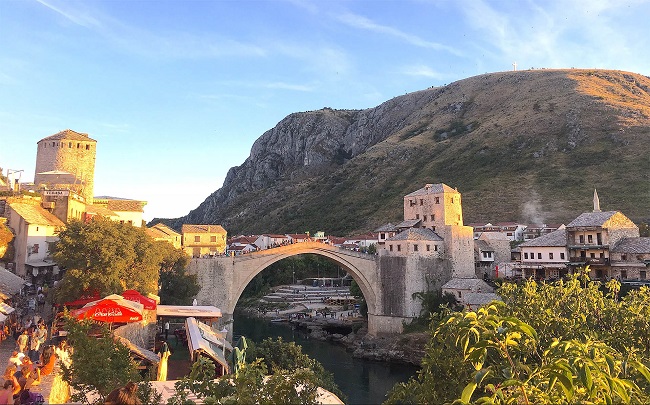
20 years ago, the newly rebuilt Stari Most in Mostar was opened
 |
Mostar - For more than four centuries, the Stari Most was an inseparable part of the Herzegovinian Mostar. It attracted not only thrill-seekers wanting to jump into the Neretva River but also crowds of tourists during the times of Yugoslavia. Everything changed during the battles of the 1990s, when the fate of this construction by the Turkish architect Mimar Hajrudin became a sad symbol of the civil war. The monument, which had little military significance, collapsed into the waves in November 1993 around ten in the morning after heavy shelling. Shortly after the bridge's destruction, discussions about its reconstruction began, but real plans had to wait until after the war ended. The rebuilt Stari Most was ceremoniously opened 20 years ago, on July 23, 2004.
The structure that gave the city its name, with its arch soaring 25 meters above the river, survived several wars that swept through the Balkans over the ages. Even the German troops retreating towards the end of World War II undermined the Stari Most but ultimately left it standing. It was the civil war that erupted in Mostar and the surrounding area in the spring of 1992 that became fatal for the bridge and the old town, including the famous bazaar known as Kujundžiluk.
Initially, Croats, who inhabited primarily the western bank of the river, fought alongside Muslims from the eastern bank against Serbian forces around Mostar. However, in the spring of 1993, former allies turned their weapons against each other. Fighting and artillery bombardments did not spare the city center, but at first, the Stari Most managed to escape the shelling. It remained the last connection between both banks of the Neretva, as the others had been blown up by the soldiers of the Yugoslav National Army before their retreat.
Eventually, though, artillery shells began to fly at the Stari Most as well. The reasons for the shelling remain a topic of speculation to this day—some Croats claimed it reminded them of Turkish oppression, while Muslims were said to have transported weapons or water across it. It is also unclear who ordered the destruction of the bridge, though the commander of the Herzegovinian Croats, Slobodan Praljak, is most frequently mentioned. In 2013, the International Criminal Tribunal for the former Yugoslavia sentenced him to 20 years for war crimes, referencing the destruction of the bridge.
Praljak, who committed suicide in the courtroom during his appeal in November 2017, asserted in his defense that the Muslims staged the collapse of the bridge, although he was unable to provide any evidence for this claim. Additionally, Croatian artillery fire lasted for several days, during which the beautiful stone arch gradually transformed into a ruin, until the final shell delivered the last blow. One of the paradoxes of the Bosnian conflict is that according to some sources, it was a Muslim in the Croatian army who fired the fateful three shells.
Shortly after the bridge's destruction, thoughts about its reconstruction emerged, but real plans had to wait until after the war ended; at least a temporary rope bridge spanned the Neretva. Fighting between Muslims and Croats subsided in the summer of 1994, but work on restoring the bridge did not begin until three years later. More than half of the original stone blocks used in the reconstruction were salvaged from the bottom of the Neretva by international forces in December 1997, while missing parts were quarried from the same site as the original material.
The actual reconstruction was carried out by the Turkish company Erbu, specializing in Ottoman-era bridges, starting in June 2001, and three years later, the last stone of the majestic bridge arch was laid. The reconstruction cost about 15 million euros (then approximately 450 million crowns), and the grand reopening of the bridge in July 2004 was attended by numerous politicians and statesmen from around the world, including the heir to the British throne, Prince Charles (now King Charles III), and the Secretary-General of UNESCO, Koichiro Matsuura.
The hope that the restoration of the bridge would miraculously eliminate the tension between the Croats and Muslims of Mostar has not been realized. Although the city has slowly recovered from the worst in recent years and gradually attracts more and more tourists, traces of the battles are still visible not only in the center, and the political scene remains divided. Both communities continue to be separated by the Neretva River, which flows through Mostar from north to south, except for a few exceptions.
The English translation is powered by AI tool. Switch to Czech to view the original text source.
0 comments
add comment










